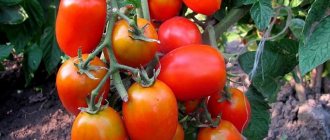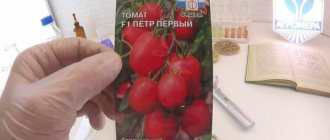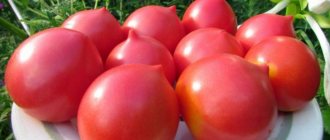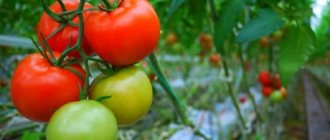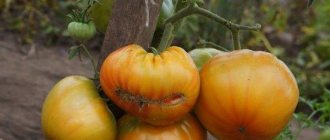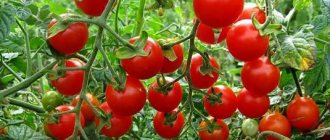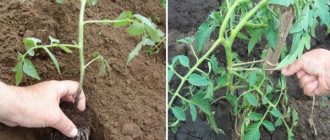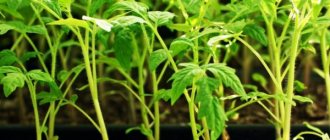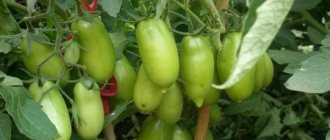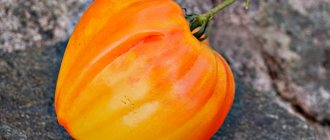Tomatoes De Barao Black: variety description
"De Barao Black" was bred in distant Brazil.
It has been known in Russia since the 90s. Received state registration as a greenhouse variety in 1997. Since then, it has earned a positive reputation among owners of tall greenhouses. “De Barao Black” is a medium-late tomato variety; it takes 115-130 days from planting seedlings to ripening the first fruits. The plant is very tall, can reach 240-300 cm. The bush is indeterminate, not standard. Resistant to most diseases, can be grown both in open ground and in greenhouse shelters. Due to its high growth, it is still better to grow in high greenhouses, as there is a possibility of damage to the plant by the wind. The species "De Barao Black" is known for its good productivity. With careful care, you can collect up to 8 kg from one bush, but usually it is 6-7 . With a planting scheme of 2 bushes per square meter. m, it turns out to be about 15 kg, which is a fairly good result.
The main advantages of these tomatoes include:
- unusual appearance;
- shade tolerance and unpretentiousness;
- resistance to temperature changes;
- good immunity to diseases;
- high yield.
Among the disadvantages are:
- may not ripen in open ground in areas with cold summers;
- does not get along well with other tomatoes;
- requires careful care in terms of pruning;
- Due to its high growth, not everyone can grow it in their greenhouses.
You can compare the yield of this variety with others in the table below:
| Variety name | Productivity |
| De Barao Black | 15 kg per square meter |
| Solerosso f1 | 8 kg per square meter |
| Soyuz 8 | 15-19 kg per square meter |
| Aurora f1 | 13-16 kg per square meter |
| Red Dome | 17 kg per square meter |
| Aphrodite f1 | 5-6 kg per bush |
| King of the Early | 12-15 kg per square meter |
| Severenok f1 | 3.5-4 kg per bush |
| Ob domes | 4-6 kg per bush |
| Katyusha | 17-20 kg per square meter |
| Pink fleshy | 5-6 kg per square meter |
Read on our website all about diseases of tomatoes in greenhouses and methods of combating these diseases. We also offer materials on high-yielding and disease-resistant varieties for your information.
Advantages and disadvantages of the variety
All professional gardeners and amateur gardeners confidently declare that the De Barao variety does not have a single drawback. But there are a lot of advantages:
- a very unpretentious representative of the nightshade family;
- has increased frost resistance;
- not demanding on the habitat, feels great even in partial shade;
- characterized by high productivity;
- stores well after removal from the bush;
- with proper care and compliance with all rules of agricultural technology, it is practically not susceptible to disease.
Advice! The variety is suitable even for beginner gardeners - the first experience, in most cases, turns out to be successful.
Characteristics
Ripe fruits are dark purple in color and round in shape. The tomatoes themselves are small, 40-70 gr. The number of chambers is 2-3, the dry matter content is about 5-6%. The collected fruits are stored for a long time and tolerate transportation well.
These tomatoes have a very high taste and are very good fresh. The fruits of "De Barao black" are perfect for whole-fruit canning and pickling. Juices and pastes are usually not made, but cooking them is also possible.
You can compare the weight of De Barao black tomatoes with others in the table below:
| Variety name | Fruit weight |
| De Barao Black | 40-70 grams |
| Diva | 120 grams |
| Yamal | 110-115 grams |
| The Golden Fleece | 85-100 grams |
| Golden heart | 100-200 grams |
| Stolypin | 90-120 grams |
| Raspberry ringing | 150 grams |
| Caspar | 80-120 grams |
| Explosion | 120-260 grams |
| Verlioka | 80-100 grams |
| Fatima | 300-400 grams |
Landing in the ground
Before transferring the seedlings to a permanent place, you need to make sure that frost has passed and the soil has warmed up sufficiently. 2-3 plants are placed on one square meter. Of course, like all tall tomatoes, the bushes need garter; for this you should build a trellis.
As they grow, the plants form 1-2 stems, then throughout the season, every week you need to remove the stepsons, leaving a small stump, it is better to do this with your hands, garden tools can carry infections. You can water “De Barao Black” a couple of times a week, preferably in the cool part of the day. It is recommended to hill up the bushes at least once every two weeks after watering, this helps strengthen the roots of the plant.
Fertilize should be at least three times per season, alternating mineral and organic fertilizers. When the fruits are fully formed and plump, the leaves under the brush can be removed, so the plant will not waste extra energy. At the time of flowering, tomatoes are treated with a solution of boric acid, dissolving 1 gram of the substance in 10 liters of water.
Photo
Features of cultivation
If this type of tomato is grown in open ground, then only southern regions, such as the Krasnodar Territory, Crimea and the Caucasus, are suitable for this. This variety can be grown in greenhouses in the regions of central Russia. Colder regions are not suitable for this type of tomato.
The features of the variety include the large growth of the bush, it can reach 300 cm, and the unusual color of its fruits. Also among the features can be noted the resistance of the species to diseases, but the main feature is that it does not tolerate proximity to other types of tomatoes.
Due to its very high growth, the De Barao Black bushes definitely need a garter, and its branches need supports. The bush is formed into 2 stems, this issue must be approached especially carefully. Tomatoes of this variety respond very well to fertilizers containing phosphorus.
Landing
Bushes are planted, maintaining a distance between the rows and inside the row from 60 to 90 cm. For gartering, stakes 2.5-3 m high should be prepared.
Plants require regular feeding. The first is produced already 2 weeks after planting - with a solution of mullein 1:6 or chicken manure 1:20. Then organic matter is added every 1-2 weeks. For this, rotted plant residues (make sure they are not weeds!) and ash are enough. Microbiological additives are added three times per season.
Growing seedlings
From sowing to planting seedlings, 60-65 days should pass. The maturity indicator of seedlings is a blast furnace from 30 cm, the presence of 5-7 leaves. Planting in the ground is possible if the temperature outside does not drop below 15 degrees; otherwise, a greenhouse is required.
Landing in the ground
Seedlings are planted at an angle of 30 degrees, with the crown facing north (so that the roots are better warmed by the sun). This unusual planting method is needed to stimulate the growth of additional roots.
Some gardeners recommend additionally, after waiting until the bushes grow to 1 meter, remove the lower leaves, take boxes with a side of 0.5 m, remove the bottom from them, place them so that the bush is in the middle and pour a soil mixture of humus and ash into the resulting container and sand.
Diseases and pests
This type of tomato has good disease resistance but can still be susceptible to bacterial black spot. To get rid of this disease, the drug “Fitolavin” is used. Fruit blossom end rot may also be affected. With this disease, the plant is sprayed with a solution of calcium nitrate and watering is reduced.
The most likely pests of this giant are the Colorado potato beetle and slugs. They fight the Colorado potato beetle by collecting it manually, then the plant is treated with the drug “Prestige”. You can fight slugs with a special solution that you can make yourself. To do this, you will need a spoon of hot pepper or dry mustard per 10 liters of water; water the ground around the bush with this solution.
This is a rather difficult variety to care for, so it is more suitable for experienced gardeners. But don’t despair, if you have already taken on the task of growing this beauty, a little effort and patience and everything will work out. Good luck in your garden plot and good harvests!
Tomato care
- Water the tomatoes once every 10 days, strictly at the root. This approach will not allow fungi to appear on leaves and fruits due to excess moisture.
- The plant needs to be fed periodically. The first procedure is carried out when planting in open soil. The second - during flowering, and the third - with the beginning of fruit ripening. Organic substances are most suitable for fertilizer and fertilizing. Humus, ash, potassium and nitrogen are the most in demand. It is recommended to alternate them with each other.
- This variety is characterized by the formation of one dense shoot. The remaining shoots, especially the lower ones, need to be trimmed by 3 cm every 2 weeks, but do this carefully so as not to cut off too many shoots.
Prevention of diseases and pests
Preventive measures will help keep plants healthy
Most fungal infections and pests are not harmful to tomatoes, but there is still a chance of infection with some diseases.
Their occurrence can be prevented with simple prevention. It is most effective to carry it out in the spring and immediately when planting plants in the ground.
When transplanting, use Bordeaux mixture (0.5%), and with the appearance of the first inflorescences - 1%. Spray all the leaves.
After 2 weeks, with the arrival of summer, a solution of colloidal sulfur is used (40 g of the substance is diluted in 5 liters of water). They treat shoots with it.
